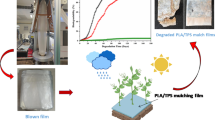Abstract
Urea-formaldehyde (UF) adhesive is the main source of formaldehyde emission from UF-bonded boards. The components in waste tea leaves can react with formaldehyde to serve as a raw material in the production of low formaldehyde emission boards. In our study, waste tea leaves and UF adhesive were employed in the preparation of waste tea leaves particleboard (WTLB). An orthogonal experimental method was applied to investigate the effects of process parameters on formaldehyde emission and mechanical properties of WTLB. The results indicated that: 1) waste tea leaves had the ability to abate formaldehyde emission from boards; and 2) density of the WTLB was a significant factor affecting its modulus of rupture (MOR), modulus of elasticity (MOE) and internal bonding (IB).
Similar content being viewed by others
References
Caffin N, D’Arcy Bruce, Yao L H, Rintoul G. 2004. Developing an Index of Quality for Australian Tea. Australia: Rural Industries Research and Development Corporation
Forrest G I, Bendall D S. 1969. The distribution of polyphenols in the tea plant. Biochem. J., 113(5): 741–755
Kim S, Kim H J. 2004. Evaluation of formaldehyde emission of pine and wattle tannin-based adhesives by gas chromatography. Holz Roh. Werkst., 62(2): 101–106
Langmaier F, Šivarová J, Mládek M, Kolomazník K. 2004. Curing adhesives of urea-formaldehyde type with collagen hydrolysates of chrome-tanned leather waste. J. Therm. Anal. Calorim., 75(1): 205–219
Li J. 1994. Wood Science. Harbin: Press of Northeast Forestry University (in Chinese)
Meyer B. 1983. Formaldehyde emission from particleboard post-cured by radio-frequency heating. Holzforschung, 37(1): 41–45
Muramatsu K. 1991. The Science of Tea. Japan: Asasou Press (in Japanese)
Pizzi A, Lipschitz L, Valenzuela J. 1994a. Theory and practice of the preparation of low formaldehyde emission UF adhesives. Holzforschung, 48(3): 254–261
Pizzi A, Valenezuela J, Westermeyer C. 1994b. Low formaldehyde emission, fast pressing, pine and pecan tannin adhesives for exterior particleboard. Holz Roh. Werkst., 52(5): 311–315
Schäfer M, Roffael E. 2000. On the formaldehyde release of wood. Holz Roh. Werkst., 58(4): 259–264
Shen T, Wang J Y. 1990. Biochemistry. Beijing: Higher Education Press (in Chinese)
Wang S, Pizzi A. 1997. Improving UF plywood adhesives water resistance by coreaction with proteins. Holz Roh. Werkst., 55(3): 158
Yalinkilic M K, Imamura Y, Takahashi M, Kalaycioglu H, Nemli G, Demirci Z, Ozdemir T. 1998. Biological, physical and mechanical properties of particleboard manufactured from waste tea leaves. Int. Biodeter. Biodegr., 41(1): 75–84
Ye Y. 2000. The application of tea leaves as feed and its prospect. China Tea, 4: 14–15 (in Chinese)
Author information
Authors and Affiliations
Corresponding author
Rights and permissions
About this article
Cite this article
Shi, Js., Li, Jz., Fan, Ym. et al. Preparation and properties of waste tea leaves particleboard. For. Stud. China 8, 41–45 (2006). https://doi.org/10.1007/s11632-006-0008-5
Received:
Accepted:
Issue Date:
DOI: https://doi.org/10.1007/s11632-006-0008-5




